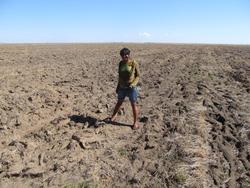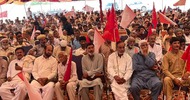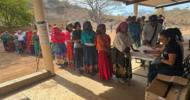Afronomics Law | 17 November 2021
The global land rush, revisited
by Lorenzo Cotula
When the US housing bubble burst in late 2008, it dragged major banks into liquidation and destabilised financial systems worldwide. A long, era-defining recession ensued, ushering bank bailouts, currency crises and austerity measures. Meanwhile, China’s skyrocketing industrial production was shifting global economic power. A spike in commodity prices — including oil, metals, maize, soybeans and palm oil — foreshadowed further rises and increased volatility in subsequent years. After its November 2008 summit of finance ministers and central bank governors, the G20 emerged as a key forum for global economic problems.
Amid this frantic succession of news, a South Korean company made the headlines when it claimed to have secured a government lease for over one million hectares of farmland in Madagascar. Company sources cited in the media suggested the venture would grow maize and oil palm on ‘undeveloped’ land, producing foodstuffs for South Korea and other export markets. Agribusiness penetration since colonial times had already established a long history of large-scale plantations in many parts of the global South. The deal in Madagascar, dubbed “the largest of its kind”, came to epitomise a new surge in corporate land acquisitions.
In the months that followed, reports of land transactions multiplied at a dizzying pace. Agribusinesses, financiers and new industry entrants — often start-ups with little capital or track record — leased large tracts of land to establish or upgrade monoculture plantations, with deals in Africa, Asia and Latin America attracting particularly extensive public attention. The surge subsided several years later, when changing commodity prices, financing bottlenecks and implementation failures pulled the rug from under many companies’ feet.
Over time, I have collaborated with researchers and practitioners to investigate the global land rush and support responses to it. This action research taught me about the material dimensions of the deals, including their scale, location, crop types, intended markets, varying degrees of implementation, and the way they shook the very foundations of local life, livelihoods and culture. It also highlighted deep-seated tensions between competing visions of agriculture, food systems, territory and society; connections to an evolving global political economy and contested notions of sovereignty and statehood; and the role the law — from land tenure systems to international trade, investment and human rights treaties — has played in facilitating the deals or resistance to them.
The “Literature Rush”
With such deep links to far-reaching policy issues, the land rush became a major field of inquiry. The rapid pace of deal-making was outdone by a sprawling literature interrogating the deals from agrarian, political, economic, legal and anthropological perspectives. Crowdsourcing experiments pioneered collective approaches to gather data, while local-to-global collaborations between scholars and activists generated evidence and sustained action. Many who worked in authoritarian contexts experienced repression and intimidation.
Initially, much research focused on contested figures of aggregate scale. A fascination with total acreage obscured more granular assessments of how the deals — often concentrated in sites with better soils, water sources and infrastructure — compounded pressure on strategic locations. Meanwhile, a focus on transnational deals concealed the role domestic elites played in land acquisition, often as part of longer-term capital accumulation processes within national societies.
Research also interrogated the conjunctural forces that triggered the rush for land. Amid the financial crisis, expectations of rising land values created opportunities for speculative capital to diversify its investment portfolios. The spike in global food prices made agriculture seem more profitable, while commodity price volatility prompted some businesses to secure agricultural supplies through greater control over farming. Public policies were at play, too: the European Union’s renewable energy legislation suggested a guaranteed demand for biofuels, and governments in Africa, Asia and Latin America vied to attract foreign investment through favourable legislation, tax incentives, ‘land banks’ and open calls to business.
But the deals’ deeper historical roots also highlight the interplay between commodity rushes and longer-term transformations. During colonialism, European powers imposed large plantations to secure raw materials for industrial activities and mass consumption back home. And starting in the ‘structural adjustment’ era, donor-dictated privatizations have enabled multinationals to acquire stakes in plantations. Agriculture ‘modernization’ policies promoted large-scale investments well before the commodity boom of the late 2000s. Since colonial times, international capital has also asserted control in agriculture by integrating small-scale farmers into agribusiness-led value chains. The land rush, then, was merely another chapter in this longer history of capitalist transformation, with distinctive features related to certain geographies, crops (such as jatropha) and the more direct involvement of global finance.
A vast body of research examined the actors, terms and outcomes of many land deals. It also documented the varying strategies of resistance and cooperation developed by the people who faced eviction, would bear the brunt of environmental degradation or stood to benefit from the infrastructure or incomes the companies were promising. The findings mostly provided a tale of land dispossession and frustrated expectations, validating many concerns of agrarian movements advocating against what became known as ‘land grabbing’.
With the research growing in breadth and depth, I learned about the power of narratives, even as evidence debunked them. These included claims that feeding the planet would justify the deals, while many ventures catered for energy and material consumption in affluent societies; that industrial farming was necessary for agricultural development, while small-scale producers have proven to be both effective and resilient; that China was driving land acquisition, while European businesses often acquired larger land areas; and that the land was ‘empty’ or ‘idle’, which merely reflects social prejudices and public policies that disenfranchise local systems of resource rights and use.
A Longer-term Perspective
As the media headlines waned, the literature eventually petered out. But if followed through, the land deals would herald long-term transformations. Although companies and governments promised jobs, the new plantations would also uproot small-scale farming, herding, foraging and off-farm occupations. As such, they set out to fundamentally remodel, rather than create, rural employment. At scale, monoculture plantations reconfigure territory, agrarian systems and social fabrics. The concession agreements undergirding them can reshape the contours of state sovereignty, for example where states have awarded land concessions to consolidate their control over marginalized areas or where insulated contractual regimes dilute the exercise of sovereign powers.
The full implications may only become apparent years into implementation, and I for one have eagerly awaited evidence on the deals’ longer-term outcomes. The transnational land rush in Africa: a decade after the spike, edited by Logan Cochrane and Nathan Andrews, provides insights on these aspects, as part of a new wave of research revisiting the global land rush. The book combines empirical studies with theoretical reflections, connecting international processes to local realties and challenging Eurocentric accounts of global political economy as a field of inquiry (introductory chapter by Andrews and Cochrane). The empirical material primarily outlines trends in selected countries, moving away from the micro-case approach that dominated some of the earlier literature.
Contingent Outcomes and Flawed Models
The book consolidates the evidence base on the historical antecedents of the land rush (for example, the chapters on Cameroon by Steffi Hamann and Adam Sneyd and on the DRC by Chris Huggins); the role of national elites, including at the highest political level, in acquiring land and partnering up with international businesses (chapter on Nigeria by Noah Echa Attah); the role of governments in making land available and proactively seeking investors (chapter on Zimbabwe by Prosper Matondi and Blair Rutherford); the varying combinations of centralized and devolved authority on which deal making rests, partly reflecting diverse political settlements and land tenure structures (chapter on Sierra Leone by Solomon Peter Gbanie and Alec Thornton); and resistance strategies, from protests to court litigation, to sabotage (chapter on Senegal by Marie Gagné and Ashley Fent).
The most salient questions, however, concern the longer-term evolution of the land deals. While the picture remains incomplete, the outlook is grim. The plantation model inherently dissociates people from control over land, leaving labour as their only resource, in contexts where on and off-farm employment opportunities are often limited. From the start, positive livelihood outcomes seemed unlikely in many cases, partly due to the often casual or seasonal nature of agricultural employment, compared with the long-term effects of land dispossession, and to the mismatches between who loses land and who gets the jobs.
But high failure rates have compounded the problems, particularly among the many ‘greenfield’ investments that sought to establish new plantations, rather than upgrade existing ones. Many projects — including the Madagascar venture that attracted so much attention — were abandoned after being announced to great fanfare. Others surrendered to financing and operational difficulties, changing commodity prices (with oil prices undercutting many biofuel businesses), stiff local opposition and escalating armed conflicts (chapter on South Sudan by Patrick Wight). Ultimately, some governments, wary of company promises, introduced restrictions or terminated contracts (chapter on Ethiopia by Melisew Dejene and Logan Cochrane).
As ever, a more granular picture reveals greater complexity. An agro-processing venture involving a state agency and national businesses in Zimbabwe, for example, was associated with a substantial number of jobs and the opening of local shops and bank branches — signs of higher disposable cash income in the locality. Around the project site, women’s greater control over incomes seemed to increase their negotiating power within the family, mirroring an aspect I encountered years ago at a site in Ghana. But the case study also pointed to land disputes and uneven and fluctuating distributions of benefits (Matondi and Rutherford chapter).
Some argue that, in capitalist systems, it should not surprise that some businesses succeed while others fail, especially when large numbers of start-ups are involved. From collaborating with scholars and practitioners in several countries, particularly in Africa, I can think of many plantation ventures that are still running — often companies with a long history of activity dating back to before the land rush and more recently taken over by established agribusinesses (see also the chapter on Cameroon by Hamann and Sneyd).
In my experience, however, even viable ventures often grapple with historical land claims or disputes with neighbouring villages. Many rest on substantial state support and the externalization and invisibility of the pain felt by those most impacted (see also the chapter on Sierra Leone by Gbanie and Thornton). As agribusiness plantations can involve land dispossession and social dislocation, we must ask how many ventures must fail — and how many lives be upended — for a business to succeed. And with many governments and companies continuing to see large-scale plantations as key to developing commercial agriculture, we must ask them at which point will the failures be accepted not as contingent outcomes but as an indictment of the model itself.
The Place of Legal Research and Action
For engaged lawyers, the land deals have provided a space to interrogate the law in its evolving socio-political contexts, departing from the confined perimeter of doctrinal analyses and seeking instead to understand how legal concepts, rules and institutions operate in complex, real-life settings. By connecting agribusiness and commodity hubs to the world’s financial centres and diverse rural realities in the global South, the deals provide a case study on how the ‘global’ penetrates the ‘local’. This unsettles conventional categories that seek to separate law from political economy and village-level action from international ordering. Making sense of these realities requires us to explore across diverse legal arenas — including local land governance, transnational contracts and international investment frameworks — that we often consider in isolation.
The results of such analysis can expose the role of law in sustaining not just the land rush and the global political economy that fostered it, but also longer-term commodification processes. Findings can also shed light on the place of hard and soft law in developing policy responses, and of rights in land activists’ recourse strategies. In more practical terms, this analytical work can help us identify entry points to support governments and activists in reconfiguring public policies, such as on land governance, foreign investment and rural development. It can help us consolidate systems for continued monitoring, shift more spotlight onto researchers and practitioners in the global South and strengthen alliances and shared learning spaces that cross national boundaries.














